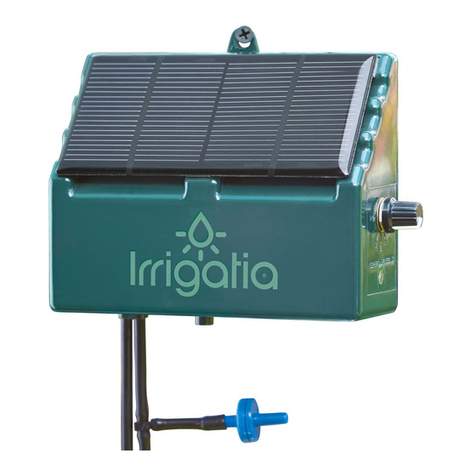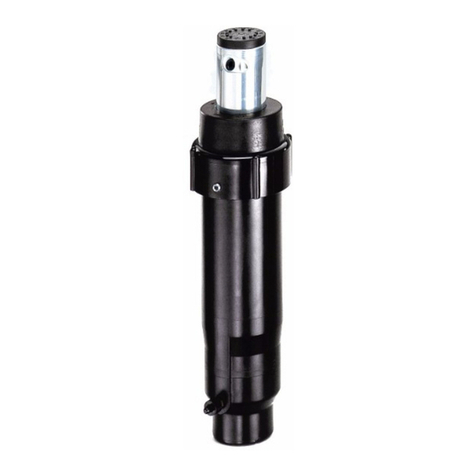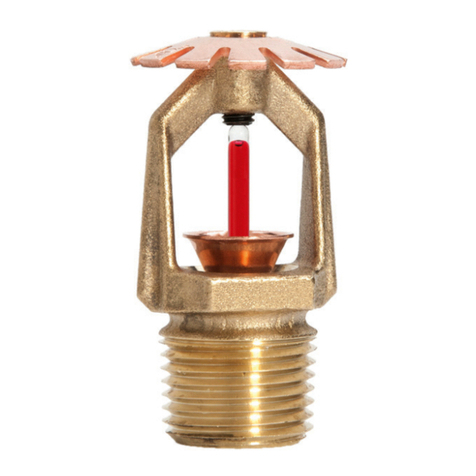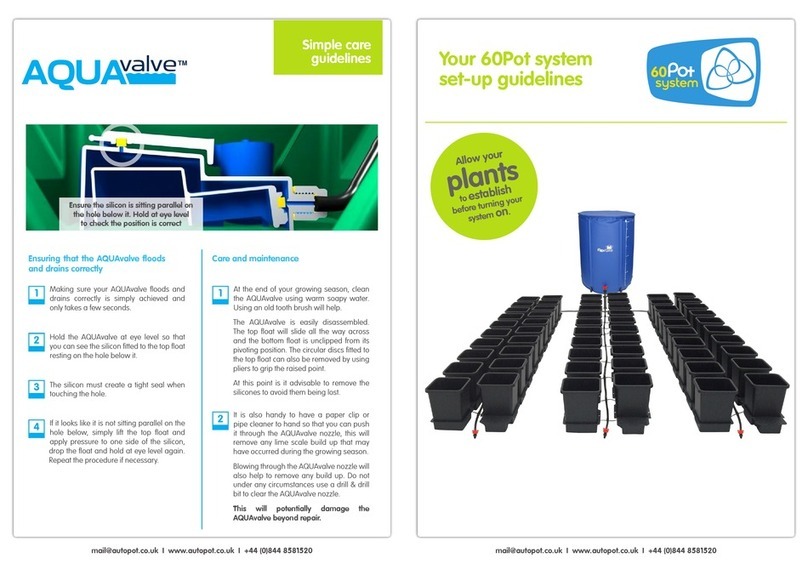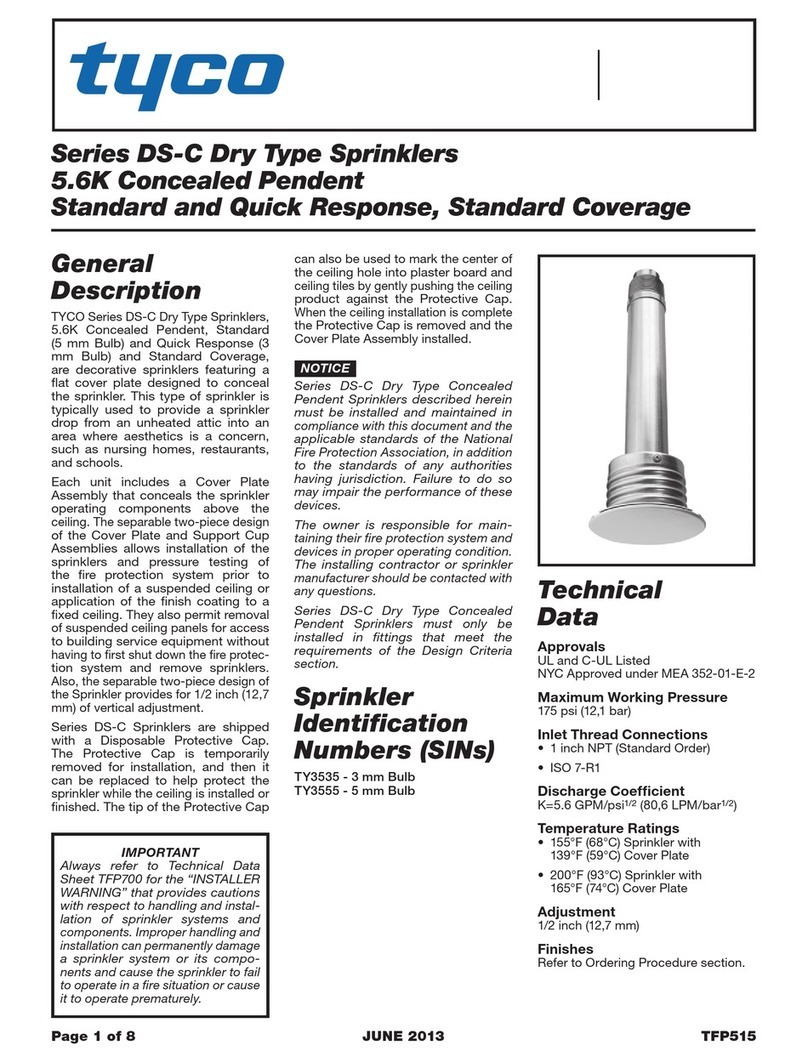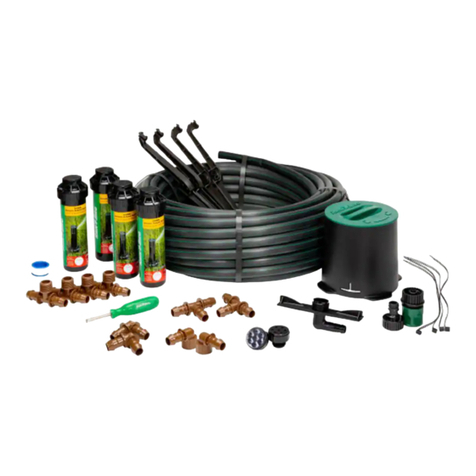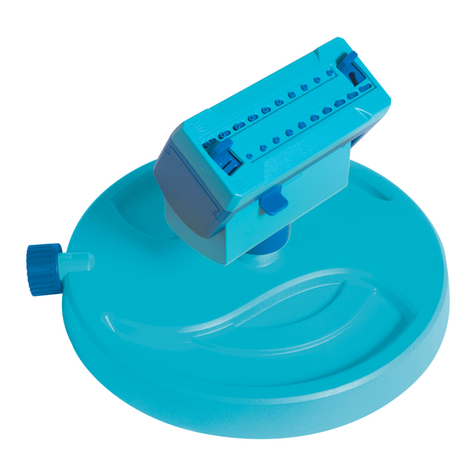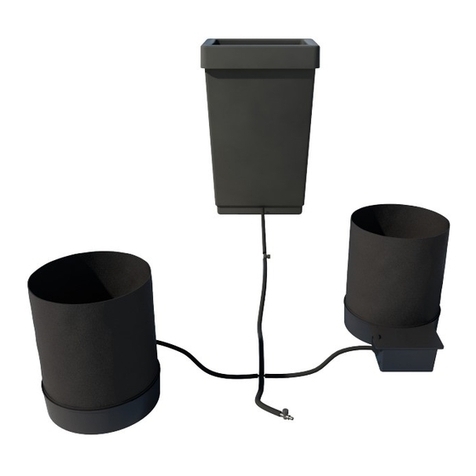Task Force Tips Mid-Force Quick guide

©Copyright Task Force Tips, Inc. 2002 - 2015 LIN-035 June 16, 2015 Rev15
MANUAL: Hand Held Automatic
Dual Pressure Nozzles
Mid-Force, CAFS-Force and Dual-Force
INSTRUCTIONS FOR SAFE OPERATION AND MAINTENANCE
WARNING Understand manual before use. Operation of this device without understanding the manual and
receiving proper training is a misuse of this equipment. Obtain safety information at www.tft.
com/serial-number
TASK FORCE TIPS, INC.
MADE IN USA • www.tft.com 3701 Innovation Way, Valparaiso, IN 46383-9327 USA
800-348-2686 • 219- 462-6161 • Fax 219-464-7155
DANGER
PERSONAL RESPONSIBILITY CODE
The member companies of FEMSA that provide emergency response
equipment and services want responders to know and understand the
following:
1. Firefighting and Emergency Response are inherently dangerous activities
requiring proper training in their hazards and the use of extreme caution
at all times.
2. It is your responsibility to read and understand any user’s instructions,
including purpose and limitations, provided with any piece of equipment
you may be called upon to use.
3. It is your responsibility to know that you have been properly trained in
Firefighting and /or Emergency Response and in the use, precautions, and
care of any equipment you may be called upon to use.
4. It is your responsibility to be in proper physical condition and to maintain
the personal skill level required to operate any equipment you may be
called upon to use.
5. It is your responsibility to know that your equipment is in operable
condition and has been maintained in accordance with the manufacturer’s
instructions.
6. Failure to follow these guidelines may result in death, burns or other
severe injury.
FEMSA
Fire and Emergency Manufacturers and Service Association
P.O. Box 147, Lynnfield, MA 01940 • www.FEMSA.org
MID-FORCE with
IMPULSE
Trigger Valve System
MID-FORCE with Bail
Valve Handle
DUAL-FORCE with Bail
Valve Handle

©Copyright Task Force Tips, Inc. 2002 - 2015 LIN-035 June 16, 2015 Rev15
2
Table Of Contents
1.0 MEANING OF SAFETY SIGNALWORDS
2.0 SAFETY
3.0 GENERALINFORMATION
3.1 VARIOUS MODELS AND TERMS
3.2 SPECIFICATIONS
3.2.1 MECHANICAL
3.3 NOZZLE COUPLINGS
3.4 USE WITH SALT WATER
4.0 FLOW CHARACTERISTICS
4.1 FLOW GRAPHS
4.2 FLOWAND RECTION CHARTS
4.3 REACHAND TRAJECTORY
5.0 NOZZLE CONTROLS
5.1 FLOW CONTROL
5.1.1 LEVER TYPE FLOW CONTROL
5.1.2 TIP ONLY
5.1.3 BALLSHUT-OFF
5.1.4 TWIST SHUT-OFF
5.1.5 IMPULSE TRIGGER HLOW CONTROL
5.1.5.1 IMPULSE TRIGGER LOCK
5.1.5.2 TRIGGER FLOW CONTROLSPEEDADJUSTMENT
5.2 PATTERN CONTROLADJUSTMENT
5.2.1 PATTERN CONTROL
5.2.2 FLUSH CONTROL
5.3 STANDARD/LOW PRESSURE KNOB MID-FORCE & DUAL-FORCE
6.0 USE WITH FOAM
6.1 FOAMASPIRATINGATTACHMENTS
7.0 USE OF NOZZLES
7.1 MID-FORCEAND DUAL-FORCE NOZZLES
7.2 CAFS-FORCE 1AND CAFS-FORCE 2 NOZZLES
8.0 APPROVALS
9.0 COLOR CODED VALVE HANDLEAND PISTOLGRIP
9.1 IMPULSE TRIGGER VALVE SYSTEM NOZZLE COLORED PISTOLGRIPS
10.0 WARRANTY
11.0 MAINTENANCE
11.1FIELD LUBRICATION
11.2IMPULSETRIGGER VALVE LUBRICATION
11.3 SERVICE TESTING
11.3.1 HYDROSTATIC TESTING
11.3.2 FLOW TESTING
11.3.3 RECORDS
11.4REPAIR
12.0 OPERATION and INSPECTION CHECKLIST

©Copyright Task Force Tips, Inc. 2002 - 2015 LIN-035 June 16, 2015 Rev15
3
1.0 MEANING OF SAFETY SIGNAL WORDS
Asafety related message is identified by a safety alert symbol and a signal word to indicate the level of risk involved with a particular
hazard. Per ANSI standard Z535.6-2011, the definitions of the four signal words are as follows:
DANGER DANGER indicates a hazardous situation which, if not avoided, will result in death or serious
injury.
WARNING WARNING indicates a hazardous situation which, if not avoided, could result in death or serious
injury.
CAUTION CAUTION indicates a potentially hazardous situation which, if not avoided, could result in minor
or moderate injury.
NOTICE NOTICE is used to address practices not related to physical injury.
2.0 SAFETY
DANGER An inadequate supply of nozzle pressure and/or flow will cause an ineffective stream and can
result in injury, death, or loss of property. See flow graphs or call 800-348-2686 for assistance.
WARNING The nozzle may be damaged if frozen while containing significant amounts of water. Such
damage may be difficult to detect visually and can lead to possible injury or death. Any time the
nozzle is subject to possible damage due to freezing, it must be tested by qualified personnel
before being considered safe for use.
WARNING This equipment is intended for use by trained personnel for firefighting. Their use for other
purposes may involve hazards not addressed by this manual. Seek appropriate guidance and
training to reduce risk of injury.
WARNING Failure to restrain nozzle reaction can cause firefighter injury from loss of footing and/or stream
protection. Nozzle reaction will vary as supply conditions change: such as opening or closing
other nozzles, hose line kinks, changes in pump settings, etc. Changes in spray pattern or
flushing will also affect nozzle reaction. The nozzle operator must always be prepared in the
event of these changes.
WARNING If nozzle gets out of control or away from operator, retreat from nozzle immediately. Do not
attempt to regain control of nozzle while flowing water. Injury from whipping can occur.
WARNING Water is a conductor of electricity. Application of water on high voltage equipment can cause
injury or death by electrocution. The amount of current that may be carried back to the nozzle
will depend on the following factors:
• Voltage of the line or equipment
• Distance from the nozzle to the line or equipment
• Size of the stream
• Whether the stream is solid or broken
• Purity of the water1
1 The Fire Fighter and Electrical Equipment, The University of Michigan Extension Service, Fourth Printing 1983. Page 47
CAUTION Fire streams are capable of injury and damage. Do not direct water stream to cause injury or
damage to persons or property.
3.0 GENERAL INFORMATION
The Task Force Tips nozzles are designed to provide excellent performance under most firefighting conditions. Their rugged
construction is compatible with the use of fresh water as well as firefighting foam solutions. Other important operating features are:
• Switchable from standard operation to low pressure
• Automatic pressure regulation (meets NFPA 1964 automatic nozzle pressure requirements)
• Slide valve for excellent stream quality at all valve positions
• Quick-acting pattern control from straight stream to wide fog
• “Power fog teeth” for full-fill fog
• “Gasket grabber” inlet screen to keep large debris from entering nozzle
• Easily flushable while flowing to clear trapped debris
• TFT’s five-year warranty and unsurpassed customer service

©Copyright Task Force Tips, Inc. 2002 - 2015 LIN-035 June 16, 2015 Rev15
4
3.1 VARIOUS MODELS AND TERMS
The nozzle is available in several different models and inlet connections. Basic body styles are shown in figure 3.1A
SERIES FLOW RANGE NOMINAL PRESSURE STANDARD COUPLING*
GPM L/min PSI BAR
MID-FORCE 70-200 265-760 100 7 1-1/2 NH
MID-FORCE 70-200 265-760 75 5 1-1/2 NH
DUAL-FORCE 95-300 360-1150 100 7 1-1/2 NH
DUAL-FORCE 95-300 360-1150 75 5 1-1/2 NH
CAFS-FORCE1 70-200 265-760 75 5 1-1/2 NH
CAFS-FORCE2 95-250 360-950 75 5 1-1/2 NH
* Other threads, coupling sizes, or connector styles can be specified at time of order.
COUPLING
RUBBER
GASKET
PISTOL
GRIP
STREAM
SHAPER
NOZZLE WITH VALVE
nd INTEGRAL PISTOL GRIPa
F
L
O
W
C
O
N
T
R
O
L
ON OFF
TIP ONLY NOZZLE
BARREL LABEL
NAME LABEL
PRESSURE
CONTROL
KNOB
VALVE HANDLE
NOZZLE WITH VALVE
GASKET
GRABBER
INLET
SCREEN
DETENTS
MID-FORCE and
DUAL-FORCE only
TIP ONLY NOZZLE
WITH TWIST SHUTOFF
VALVE POSITION
LABEL VALVE RING
NOZZLE WITH IMPULSE TRIGGER VALVE SYSTEM
OFFON
TRIGGER
4 POSITION LOCK
3.1A COMMON MODELS AND TERMS

©Copyright Task Force Tips, Inc. 2002 - 2015 LIN-035 June 16, 2015 Rev15
5
3.2 SPECIFICATIONS
3.2.1 MECHANICAL
Maximum nozzle inlet pressure with
valve shutoff 300 psi 21 bar
Operating temperature range of fluid 33 to 120º F 1 to 50º C
Storage temperature range -40 to 150º F -40 to 65º C
Materials used Aluminum 6000 series hard anodized MIL8625 class 3 type 2,
stainless steel 300 series, nylon 6-6, nitrile rubber
3.3 NOZZLE COUPLINGS
Many inlet couplings such as NH (National Hose) or NPSH (National Pipe Straight Hose) can be specified at time of order.
CAUTION Nozzle must be mated to a hose line with matched threads. Mismatched or damaged threads may
cause nozzle to leak or uncouple under pressure and could cause injury.
CAUTION Dissimilar metals coupled together can cause galvanic corrosion that can result in the inability
to unscrew the threads or complete loss of thread engagement over time. Per NFPA 1962, if
dissimilar metals are left coupled together an anti-corrosive lubricant should be applied to the
threads. Also the coupling should be disconnected and inspected at least quarterly.
3.4 USE WITH SALT WATER
Use with saltwater is permissible provided nozzle is thoroughly cleaned with fresh water after each use. The service life of the nozzle
may be shortened due to the effects of corrosion and is not covered under warranty.
4.0 FLOW CHARACTERISTICS
The following graphs show the typical performance of MID-FORCE, CAFS-FORCE and DUAL-FORCE nozzles.
SPECIAL CONFIGURATIONS - If nozzles are made according to the special marking or performance requirements of the fire
department then the operating characteristics may differ from the published data in this manual. Repair parts specific to each serial
number may differ from those shown in the service procedure. The required parts for each serial number are available on-line by
entering www.tft.123456 with the numbers corresponding to the serial number engraved on the product.

©Copyright Task Force Tips, Inc. 2002 - 2015 LIN-035 June 16, 2015 Rev15
6
4.1 FLOW GRAPHS
meets NFPA flow requirements
.
115 PSI
200 GPM
85 PSI
0
10
20
30
40
50
60
70
80
90
100
110
120
0 20 40 60 80 100 120 140 160 180 200 220 240 260 280 300 320
Pressure (PSI)
Flow (GPM)
MID-FORCE
100/55 PSI (7/4 BAR)
STANDARD 100 PSI LOW 55 PSI NFPA 100 PSI NFPA 55 PSI
70 GPM
STANDARD PRESSURE MODE
70 - 200 GPM (265 - 760 L/min)
FLOW RANGE
LOW PRESSURE MODE
90 PSI
200 GPM
60 PSI
0
10
20
30
40
50
60
70
80
90
100
110
120
0 20 40 60 80 100 120 140 160 180 200 220 240 260 280 300 320
Pressure (PSI)
Flow (GPM)
MID-FORCE
75/45 PSI (5/3 BAR)
STANDARD 75PSI LOW 45PSI NFPA 75 PSI NFPA 45 PSI
70 GPM
STANDARD PRESSURE MODE
70 - 200 GPM (265 - 760 L/min)
FLOW RANGE
LOW PRESSURE MODE
CAFS-Force 1
CAFS-FORCE 1 75/45 PSI (5/3 BAR)
0
10
20
30
40
50
60
70
80
90
100
0 20 40 60 80 100 120 140 160 180 200 220 240 260 280 300 320
FLOW (GPM)
WATER MODE CAF MODE NFPA75 PSI
PRESSURE(PSI)
CAF MODE
WATER MODE
90 PSI
60 PSI
75 GPM
200 GPM
The charts in section 4.2 of this document give specific examples of maximum flow rates for particular situations. Friction losses
may vary due to differences in hose construction resulting in flows different than those shown. For situations or lengths of hose not
listed on the chart, approximate flows can be calculated using conventional hydraulics. NOTE: Within the flow range, the nozzle inlet
pressure may be approximated to be 100 or 75 PSI, when used in the standard pressure mode, and 55 or 45 PSI in low pressure
mode.

©Copyright Task Force Tips, Inc. 2002 - 2015 LIN-035 June 16, 2015 Rev15
7
meets NFPA flow requirements.
For Nozzles Manufactured
After December 1, 2003
115 PSI
300 GPM
85 PSI
70 PSI
225 GPM
40 PSI
0
10
20
30
40
50
60
70
80
90
100
110
120
0 20 40 60 80 100 120 140 160 180 200 220 240 260 280 300 320
Pressure (PSI)
Flow (GPM)
New DUAL-FORCE 100/55 PSI (7/4 BAR)
meets NFPA -
For Nozzles Manufactured After December 1, 2003
STANDRAD 100 PSI LOW 55 PSI NFPA 100 PSI NFPA 55 PSI
95 GPM
STANDARD PRESSURE MODE
95 - 300 GPM (360 - 1150 L/min)
FLOW RANGE
LOW PRESSURE MODE
95 - 225 GPM (360 - 850 L/min)
FLOW RANGE
90 PSI
250 GPM
60 PSI
225 GPM
30 PSI
0
10
20
30
40
50
60
70
80
90
100
110
120
0 20 40 60 80 100 120 140 160 180 200 220 240 260 280 300 320
Pressure (PSI)
Flow (GPM)
New DUAL-FORCE 75/45 PSI (5/3 BAR)
meets NFPA -
For Nozzles Manufactured after December 1, 2003
STANDRAD 75PSI LOW 45PSI NFPA 75 PSI NFPA 45 PSI
95 GPM
STANDARD PRESSURE MODE
95 - 250 GPM (360 - 950 L/min)
FLOW RANGE
LOW PRESSURE MODE
95 - 225 GPM (360 - 850 L/min)
FLOW RANGE
CAFS-Force 2
0
10
20
30
40
50
60
70
80
90
100
0 20 40 60 80 100 120 140 160 180 200 220 240 260 280 300 320
FLOW (GPM)
WATER MODE CAF MODE NFPA 75 PSI
PRESSURE(PSI)
CAFS-FORCE 2 75/45 PSI (5/3 BAR)
90 PSI
60 PSI
95 GPM
250 GPM
WATER MODE
CAF MODE
FIGURE 3 - NOZZLE PERFORMANCE
(on pages 6 - 7)

©Copyright Task Force Tips, Inc. 2002 - 2015 LIN-035 June 16, 2015 Rev15
8
4.2 FLOW AND REACTION CHARTS
Flow And Nozzle Reaction Chart
CAUTION: Changing to Low Pressure mode will typically increase nozzle reaction.
150 ft. 150 ft. 150 ft.200 ft. 200 ft. 200 ft.250 ft. 250 ft.
50
225
200
175
150
125
100
75
21
31
65
93
117
140
162
183
8
13
30
45
59
72
84
94
55
93
121
143
163
180
196
209
17
31
42
52
61
69
78
87
21
29
59
84
105
124
141
158
7
12
27
40
52
63
73
82
50
83
107
126
143
159
173
186
16
27
36
44
52
59
66
72
21
28
55
77
96
112
128
142
7
12
25
37
47
57
65
73
46
75
97
114
130
143
156
168
14
24
32
39
46
52
58
63
21
32
72
108
141
174
204
---
8
14
34
54
72
90
105
---
65
111
143
172
195
213
228
---
21
38
52
65
77
90
102
---
21
32
67
97
125
151
175
198
8
14
32
48
63
78
91
102
60
100
129
152
174
192
207
221
19
33
45
56
66
76
86
96
21
31
63
91
114
136
157
176
7
13
29
44
57
70
81
91
54
91
117
138
158
175
189
203
17
30
40
50
58
66
75
83
22
36
84
135
196
---
---
---
8
15
41
69
101
---
---
---
82
141
184
213
---
---
---
---
27
51
72
90
---
---
---
---
22
35
79
122
168
212
---
---
8
15
38
62
87
109
---
---
75
128
167
198
220
---
---
---
24
45
63
79
95
---
---
---
113
151
187
222
113
PUMP DISCHARGE PRESSURE (PSI)
1 1/2" HOSE 1 3/4" HOSE 2" HOSE
STD STD STD STD STD STD STD STD STDLP LP LP LP LP LP LP LP
(1) Number on top in each box indicates flow (GPM), and number on bottom indicates nozzle reaction (LBS). (2) In Standard mode, the average nozzle pressure is 100 PSI. (3) Flows may vary with brand or condition of hose. (4)
Flows are approximate and do not reflect losses in preconnect piping.
FLOW (GPM)
REACTION
(LBS)
= STANDARD PRESSURE MODE
= LOW PRESSURE MODE
STD
LP
100/55 PSI
250 ft.
22
34
75
---
8
15
36
57
78
97
---
68
119
153
182
205
223
---
---
22
41
56
70
84
98
---
---
LP

©Copyright Task Force Tips, Inc. 2002 - 2015 LIN-035 June 16, 2015 Rev15
9
Flow And Nozzle Reaction Chart
CAUTION: Changing to Low Pressure mode will typically increase nozzle reaction.
45M 45M 45M60M 60M 60M75M 75M 75M
3.5
15.5
14.0
12.0
10.0
8.6
7.0
5.2
80
115
245
350
445
530
615
695
4
6
14
20
27
33
38
43
210
350
460
540
615
680
740
790
8
14
19
24
28
31
35
40
80
110
225
320
395
470
535
600
3
5
12
18
24
29
33
37
190
315
405
475
540
600
655
705
7
12
16
20
24
27
30
33
80
105
210
290
365
425
485
535
3
5
11
17
21
26
30
33
175
285
365
430
490
540
590
635
6
11
15
18
21
24
26
29
80
85
275
410
535
660
770
---
4
6
15
25
33
41
48
---
245
420
540
650
740
805
---
---
10
17
24
30
35
41
---
---
80
120
255
365
475
570
660
750
4
6
15
22
29
35
41
46
225
380
490
575
660
725
785
835
9
15
20
25
30
35
39
44
80
115
240
345
430
515
595
665
3
6
13
20
26
32
37
41
205
345
445
520
600
660
715
770
8
14
18
23
26
30
34
38
85
135
320
510
740
---
---
---
4
175
19
31
46
---
---
---
310
535
695
805
---
---
---
---
12
23
33
41
---
---
---
---
85
130
300
460
635
800
---
---
4
7
17
28
40
50
---
---
285
485
630
750
---
---
---
---
11
20
29
36
--
---
---
---
85
130
285
430
570
710
840
---
4
7
16
26
35
44
51
---
38mm HOSE 45mm HOSE 50mm HOSE
7 barLP LP LP LP LP LP LP LP
(1) Number on top in each box indicates flow (LPM), and number on bottom indicates nozzle reaction (KG). (2) In Standard mode, the average nozzle pressure is 7 bar. (3) Flows may vary with brand or condition of hose. (4) Flows are
approximate and do not reflect losses in preconnect piping.
FLOW (LPM)
REACTION
(KG)
= STANDARD PRESSURE MODE
= LOW PRESSURE MODE
7 bar
LP
7 bar7 bar 7 bar 7 bar7 bar 7 bar7 bar7 bar
7/4 BAR
225
450
580
690
775
845
---
---
10
19
25
32
38
45
---
---
PUMP DISCHARGE PRESSURE (BAR)
LP

©Copyright Task Force Tips, Inc. 2002 - 2015 LIN-035 June 16, 2015 Rev15
Flow And Nozzle Reaction Chart
CAUTION: Changing to Low Pressure mode will typically increase nozzle reaction.
150 ft. 150 ft. 150 ft.200 ft. 200 ft. 200 ft.250 ft. 250 ft.
50
225
200
175
150
125
100
75
PUMP DISCHARGE PRESSURE (PSI)
1 1/2" HOSE 1 3/4" HOSE 2" HOSE
STD STD STD STD STD STD STD STD STDLP LP LP LP LP LP LP LP
(1) Number on top in each box indicates flow (GPM), and number on bottom indicates nozzle reaction (LBS). (2) In Standard mode, the average nozzle pressure is 100 PSI. (3) Flows may vary with brand or condition of hose. (4)
FLOW (GPM)
REACTION
(LBS)
= STANDARD PRESSURE MODE
= LOW PRESSURE MODE
STD
LP
75/45 PSI
250 ft.
43
55
78
108
136
162
183
204
14
22
35
50
63
73
82
90
69
104
127
149
166
180
192
204
20
32
42
50
60
70
79
89
43
53
72
96
119
138
157
174
14
21
32
43
54
64
72
79
62
92
113
131
148
163
174
184
18
27
35
43
50
57
65
73
42
51
68
86
106
124
140
155
16
24
31
38
44
50
55
62
13
20
29
39
49
57
64
71
45
59
91
134
173
206
220
---
84
121
153
174
191
206
220
---
15
24
41
62
78
91
104
---
25
39
52
65
78
91
104
---
44
57
82
118
148
175
201
214
74
110
136
159
174
189
202
214
15
23
37
54
68
79
88
98
21
34
45
55
66
77
87
98
43
55
77
105
132
155
176
196
67
101
123
145
162
175
188
199
14
22
34
48
60
71
80
86
19
30
40
48
57
66
76
85
45
64
122
203
ó
ó
ó
ó
84
155
182
204
ó
ó
ó
---
97
140
171
192
210
ó
ó
ó
45
62
105
166
210
ó
ó
ó
45
60
97
146
189
215
ó
ó
25
53
71
89
ó
ó
ó
---
15
27
56
89
ó
ó
ó
---
29
47
63
79
95
ó
ó
---
16
26
48
75
95
ó
ó
---
15
25
44
67
85
99
ó
---
57
83
103
119
134
147
160
170
LP
89
128
162
181
199
214
ó
ó
26
42
56
70
85
99
ó
---

©Copyright Task Force Tips, Inc. 2002 - 2015 LIN-035 June 16, 2015 Rev15
Flow And Nozzle Reaction Chart
CAUTION: Changing to Low Pressure mode will typically increase nozzle reaction.
45M 45M 45M60M 60M 60M75M 75M 75M
3.5
15.5
14.0
12.0
10.0
8.6
7.0
5.2
38mm HOSE 45mm HOSE 50mm HOSE
5 barLP LP LP LP LP LP LP LP
(1) Number on top in each box indicates flow (LPM), and number on bottom indicates nozzle reaction (KG). (2) In Standard mode, the average nozzle pressure is 7 bar. (3) Flows may vary with brand or condition of hose. (4) Flows are
approximate and do not reflect losses in preconnect piping.
FLOW (LPM)
REACTION
(KG)
= STANDARD PRESSURE MODE
= LOW PRESSURE MODE
7 bar
LP
5 bar5 bar 5 bar 5 bar5 bar 5 bar5 bar5 bar
5/3 BAR
PUMP DISCHARGE PRESSURE (BAR)
LP
261
394
481
564
628
681
727
772
163
208
295
409
515
613
693
772
6
10
16
23
29
33
37
41
9
15
19
23
27
32
36
40
163
201
273
363
450
522
594
659
235
348
428
496
560
617
659
696
8
12
16
20
23
26
29
33
6
10
15
20
24
29
33
36
216
314
390
450
507
556
606
643
159
193
257
326
401
469
530
587
7
11
14
17
20
23
25
28
6
9
13
18
22
26
29
32
318
458
579
659
723
780
833
---
170
223
344
507
655
780
833
---
11
18
24
29
35
41
47
---
7
11
19
28
35
41
47
---
280
416
515
602
659
715
765
810
167
216
310
447
560
662
761
810
10
15
20
25
30
35
39
44
9
14
18
22
26
30
34
39
254
382
466
549
613
662
712
753
163
208
291
397
500
587
666
742
6
10
15
22
27
32
36
39
318
587
689
772
ó
ó
ó
ó
170
242
462
768
ó
ó
ó
ó
11
24
32
40
ó
ó
ó
---
7
12
25
40
ó
ó
ó
---
367
530
647
727
795
ó
ó
ó
170
235
397
628
795
ó
ó
ó
13
21
29
36
43
ó
ó
---
7
12
22
34
43
ó
ó
---
337
484
613
685
753
810
ó
ó
170
227
367
553
715
814
ó
ó
12
19
25
32
39
45
ó
ó
7
11
20
30
39
45
ó
---
7
12
19
25
31
36
40
44

©Copyright Task Force Tips, Inc. 2002 - 2015 LIN-035 June 16, 2015 Rev15
Flow And Nozzle Reaction Chart
150 ft. 150 ft. 150 ft.200 ft 200 ft 200 ft250 ft. 250 ft. 250 ft.
1 1/2" HOSE 1 3/4" HOSE 2" HOSE
50
250
225
200
175
150
125
100
75
PUMP DISCHARGE PRESSURE (PSI)
16
23
33
47
60
72
83
93
102
STD STD STD STD STD STD STD STD STDLP LP LP LP LP LP LP LP LP
CAUTION: Changing to Low Pressure mode will typically increase nozzle reaction.
(1) Number on top of each box indicates flow (GPM), and number on bottom indicates nozzle reaction (LBS). (2) In Standard mode, the average nozzle pressure is 100
PSI. (3) Flows may vary with brand or condition of hose. (4) Flows are approximate and do not reflect losses in preconnect piping.
FLOW
(GPM)
REACTION
(LBS)
= STANDARD PRESSURE MODE
= LOW PRESSURE MODE
STD
LP
48
59
74
100
124
146
165
183
199
54
91
118
141
160
178
194
209
223
47
57
69
89
110
128
145
160
174
50
80
104
124
141
157
171
184
196
45
56
65
82
100
116
131
144
157
47
72
94
112
128
142
154
166
177
17
31
41
51
60
68
76
84
91
15
22
30
42
53
63
72
80
88
15
27
36
44
51
58
64
71
77
14
21
28
38
47
56
64
71
81
15
23
33
46
59
71
81
91
100
50
61
83
119
151
179
204
227
248
62
110
144
172
196
217
237
255
269
49
60
77
107
134
158
179
199
216
56
98
128
152
174
193
210
226
241
48
59
73
98
122
143
162
179
195
50
61
86
126
160
190
217
242
264
17
25
38
58
75
91
105
117
129
14
24
32
39
45
51
57
62
67
20
38
52
65
77
88
99
110
122
16
24
35
51
66
79
91
101
112
18
33
45
56
66
75
84
93
102
17
25
40
61
80
97
112
126
139
53
89
116
138
157
175
190
205
218
51
63
99
152
198
238
273
307
329
76
141
185
221
252
274
294
311
328
51
62
91
136
176
210
240
268
293
70
127
166
199
227
251
270
287
303
65
116
152
182
208
230
250
268
283
17
30
40
50
58
66
74
81
89
18
27
47
76
101
124
144
163
181
25
51
71
90
108
126
144
163
181
17
26
43
67
89
108
125
141
155
23
45
62
78
93
108
123
138
154
21
40
56
70
80
95
108
121
134
150 ft. 200 ft 250 ft.
2 1/2" HOSE
STD STD STDLP LP LP
53
65
122
207
283
331
---
---
---
19
28
59
106
149
183
---
---
---
53
65
135
245
328
---
---
---
---
107
206
265
299
326
---
---
---
---
53
65
128
223
312
340
---
---
---
102
194
254
288
315
340
---
---
---
97
184
242
279
306
329
---
---
---
19
28
66
128
179
---
---
---
---
37
82
119
149
179
---
---
---
---
19
28
62
115
166
195
---
---
---
35
76
110
139
167
195
---
---
---
33
71
103
130
156
182
---
---
---
100/55 PSI
For Nozzles with: Serial # TFT-H465101 and over or Manufactured after 12/01/2003

©Copyright Task Force Tips, Inc. 2002 - 2015 LIN-035 June 16, 2015 Rev15
For Nozzles with: Serial # TFT-H465101 and over or Manufactured after 12/01/2003
45M 45M 45M60M 60M 60M75M 75M 75M
38mm HOSE 45mm HOSE 50mm HOSE
3.5
17.0
15.5
14.0
12.0
10.0
8.6
7.0
5.2
PUMP DISCHARGE PRESSURE (bar)
7
10
15
21
27
33
38
42
46
7 barLP LP LP LP LP LP LP LP LP
CAUTION: Changing to Low Pressure mode will typically increase nozzle reaction.
(1) Number on top of each box indicates flow (GPM), and number on bottom indicates nozzle reaction (LBS). (2) In Standard mode, the average nozzle pressure is 100
PSI. (3) Flows may vary with brand or condition of hose. (4) Flows are approximate and do not reflect losses in preconnect piping.
FLOW
(l/min)
REACTION
(KG)
= STANDARD PRESSURE MODE
= LOW PRESSURE MODE
7 bar
LP
182
223
280
379
469
553
625
693
753
204
344
447
534
606
674
734
791
844
178
216
261
337
416
484
549
606
659
189
303
394
469
534
594
647
696
742
170
212
246
310
379
439
496
545
594
178
273
356
424
484
537
583
628
670
8
14
19
23
27
31
34
38
41
7
10
14
19
24
29
33
36
40
7
12
16
20
23
26
29
32
35
6
10
13
17
21
25
29
32
35
7
10
15
21
27
32
37
41
45
189
231
314
450
572
678
772
859
939
235
416
545
651
742
821
897
965
1018
185
227
291
405
507
598
678
753
818
212
371
484
575
659
731
795
855
912
182
223
276
371
462
541
613
678
738
189
231
326
477
606
719
821
916
999
8
11
17
26
34
41
48
53
59
6
11
15
18
20
23
26
28
30
9
17
24
29
35
40
45
50
55
7
11
16
23
30
36
41
46
51
8
15
20
25
30
34
38
42
46
8
11
18
28
36
44
51
57
63
201
337
439
522
594
662
719
776
825
193
238
375
575
749
901
1033
1162
1245
288
534
700
836
954
1037
1113
1177
1241
193
235
344
515
666
795
908
1014
1109
265
481
628
753
859
950
1022
1086
1147
246
439
575
689
787
871
946
1014
1071
8
14
18
23
26
30
34
37
40
8
12
21
34
46
56
65
74
82
11
23
32
41
49
57
65
74
82
8
12
20
30
40
49
57
64
70
10
20
28
35
42
49
56
63
70
10
18
25
32
38
43
49
55
61
45M 60M 75M
64mm HOSE
LP LP LP
201
246
462
783
1071
1253
ó
ó
---
9
13
27
48
68
83
ó
ó
---
201
246
511
927
1241
ó
ó
ó
ó
405
780
1003
1132
1234
ó
ó
ó
---
201
246
484
844
1181
1287
---
ó
---
386
734
961
1090
1192
1287
ó
ó
ó
367
696
916
1056
1158
1245
ó
ó
---
9
13
30
58
81
ó
ó
ó
---
17
37
54
68
81
ó
ó
ó
---
9
13
28
52
75
88
ó
ó
---
16
34
50
63
76
88
ó
ó
---
15
32
47
59
71
83
ó
ó
---
7 bar 7 bar 7 bar 7 bar 7 bar7 bar 7 bar 7 bar7 bar 7 bar 7 bar
7/4 BAR
Flow And Nozzle Reaction Chart

©Copyright Task Force Tips, Inc. 2002 - 2015 LIN-035 June 16, 2015 Rev15
Flow And Nozzle Reaction Chart
150 ft. 150 ft. 150 ft.200 ft 200 ft 200 ft250 ft. 250 ft. 250 ft.
1 1/2" HOSE 1 3/4" HOSE 2" HOSE
50
250
225
200
175
150
125
100
75
PUMP DISCHARGE PRESSURE (PSI)
16
25
39
52
63
72
81
89
97
STD STD STD STD STD STD STD STD STDLP LP LP LP LP LP LP LP LP
CAUTION: Changing to Low Pressure mode will typically increase nozzle reaction.
(1) Number on top of each box indicates flow (GPM), and number on bottom indicates nozzle reaction (LBS). (2) In Standard mode, the average nozzle pressure is 100
PSI. (3) Flows may vary with brand or condition of hose. (4) Flows are approximate and do not reflect losses in preconnect piping.
FLOW
(GPM)
REACTION
(LBS)
= STANDARD PRESSURE MODE
= LOW PRESSURE MODE
STD
LP
48
64
96
122
145
165
183
200
216
71
104
130
151
170
187
202
216
229
47
60
85
108
124
144
160
174
188
65
91
114
133
149
164
178
190
202
45
58
77
98
115
130
144
157
169
60
82
103
120
135
148
160
172
182
20
31
41
49
57
65
72
80
88
15
23
34
45
54
62
70
77
83
18
27
35
42
48
55
61
66
72
14
22
31
40
48
56
62
68
74
15
25
38
50
61
70
79
87
94
50
73
115
149
177
203
227
249
269
84
126
157
183
206
225
241
257
271
49
67
103
131
156
178
198
216
234
75
112
139
162
182
201
217
231
244
48
63
93
119
141
160
178
195
210
50
76
121
158
189
217
243
266
284
17
29
48
64
78
91
102
113
123
16
24
31
37
43
48
53
58
63
25
39
52
63
74
86
98
109
122
16
26
42
56
68
79
88
97
106
22
34
44
54
63
71
80
90
99
17
31
51
69
84
98
110
121
133
70
101
126
147
165
182
197
211
223
51
88
148
197
239
276
295
312
329
107
162
203
232
256
276
295
313
336
51
81
132
173
210
242
270
289
304
96
145
182
212
234
255
272
288
304
88
133
166
194
218
236
254
269
284
20
30
39
48
55
63
70
77
85
18
36
64
88
108
127
145
163
181
33
54
72
90
108
127
145
163
180
17
33
57
76
94
109
123
138
154
29
47
63
77
92
108
123
138
154
26
42
56
68
81
94
107
120
134
150 ft. 200 ft 250 ft.
2 1/2" HOSE
STD STD STDLP LP LP
53
111
206
282
307
343
356
368
380
18
46
92
131
157
186
210
232
255
53
123
252
300
343
356
369
ó
---
157
230
269
300
341
355
368
ó
---
53
116
224
290
317
349
362
375
ó
148
221
260
290
335
348
361
373
ó
140
212
251
281
307
342
354
367
378
19
52
114
150
185
210
235
ó
---
52
89
120
150
185
209
234
ó
---
19
49
101
140
167
198
222
245
---
48
83
112
140
173
197
221
245
---
45
77
105
131
157
186
209
232
255
75/45 PSI
For Nozzles with: Serial # TFT-H465101 and over or Manufactured after 12/01/2003

©Copyright Task Force Tips, Inc. 2002 - 2015 LIN-035 June 16, 2015 Rev15
For Nozzles with: Serial # TFT-H465101 and over or Manufactured after 12/01/2003
45M 45M 45M60M 60M 60M75M 75M 75M
38mm HOSE 45mm HOSE 50mm HOSE
3.5
17.0
15.5
14.0
12.0
10.0
8.6
7.0
5.2
PUMP DISCHARGE PRESSURE (bar)
7
11
18
24
29
33
37
40
44
5 barLP LP LP LP LP LP LP LP LP
CAUTION: Changing to Low Pressure mode will typically increase nozzle reaction.
(1) Number on top of each box indicates flow (GPM), and number on bottom indicates nozzle reaction (LBS). (2) In Standard mode, the average nozzle pressure is 100
PSI. (3) Flows may vary with brand or condition of hose. (4) Flows are approximate and do not reflect losses in preconnect piping.
FLOW
(l/min)
REACTION
(KG)
= STANDARD PRESSURE MODE
= LOW PRESSURE MODE
7 bar
LP
182
242
363
462
549
625
693
757
818
269
394
492
572
643
708
765
818
867
178
227
322
409
481
545
606
659
712
246
344
431
503
564
621
674
719
765
170
220
291
371
435
492
545
594
640
227
310
390
454
511
560
606
651
689
8
14
19
23
27
31
34
38
41
7
10
15
20
24
28
32
35
38
8
12
16
19
22
25
28
30
33
6
10
14
18
22
25
28
31
34
7
11
17
23
28
32
36
39
43
189
276
435
564
670
768
859
942
1018
318
477
594
693
780
852
912
973
1026
185
254
390
496
590
674
749
818
886
284
424
526
613
689
761
821
874
924
182
238
352
450
534
606
674
738
795
189
288
458
598
715
821
920
1007
1075
8
13
22
29
35
41
46
51
56
7
11
14
17
20
22
24
26
29
11
18
24
29
34
39
44
49
55
7
12
19
25
31
36
40
44
48
10
15
20
24
29
32
36
41
45
8
14
23
31
38
44
50
55
60
265
382
477
556
625
689
746
799
844
193
333
560
746
905
1045
1117
1181
1245
405
613
768
878
969
1045
1117
1185
1272
193
307
500
655
795
916
1022
1094
1151
363
549
689
802
886
965
1030
1090
1151
333
503
628
734
825
893
961
1018
1075
9
14
18
22
25
29
32
35
39
8
16
29
40
49
58
66
74
82
15
24
33
41
49
58
66
74
82
8
15
26
34
43
49
56
63
70
13
21
29
35
42
49
56
63
70
45M 60M 75M
64mm HOSE
LP LP LP
201
420
780
1067
1162
1298
1347
1393
1438
8
21
42
59
71
84
95
105
116
201
466
954
1136
1298
1347
1397
ó
ó
594
871
1018
1136
1291
1344
1393
ó
---
201
439
848
1098
1200
1321
1370
1419
---
560
836
984
1098
1268
1317
1366
1412
ó
530
802
950
1064
1162
1294
1340
1389
1431
9
24
52
68
84
95
107
ó
---
24
40
54
68
84
95
106
ó
---
9
22
46
64
76
90
101
111
---
22
38
51
64
78
89
100
111
---
20
35
48
59
71
84
95
105
116
5 bar 5 bar 5 bar 5 bar 5 bar5 bar 5 bar 5 bar5 bar 7 bar 5 bar
5/3 BAR
Flow And Nozzle Reaction Chart
12
19
25
31
37
43
49
54
61

©Copyright Task Force Tips, Inc. 2002 - 2015 LIN-035 June 16, 2015 Rev15
16
4.3 REACH AND TRAJECTORY
Care must be taken to avoid dents or nicks in the nozzle tip because they can seriously affect the stream reach.
The following are specific examples of maximum flow rates for particular situations. Friction losses may vary due to differences in
hose construction resulting in flows different than those shown. For situations or lengths of hose not listed on the chart, approximate
flows can be calculated using conventional hydraulics.
All reach testing was taken in still air conditions at an elevation of 30 degrees.
MID-FORCE
Flow range 70-200 GPM, automatic pressure
control at emergency low pressure mode.
NOZZLE TESTED
Mid-Force
Model: HM-VPGI
Serial #: TFTH-145249
MODEL
HD-VPGI
SHOWN
DUAL-FORCE
Flow range 70-250 GPM, automatic pressure
control with 100 PSI and emergency low
pressure mode.
NOZZLE TESTED
DUAL-FORCE
Model: HD-VPGI
Serial #: TFTH-041501

©Copyright Task Force Tips, Inc. 2002 - 2015 LIN-035 June 16, 2015 Rev15
17
5.0 NOZZLE CONTROLS
Nozzle control valves must be opened slowly to eliminate unnecessary strain on the hose and couplings and reduce pressure surges.
5.1 FLOW CONTROL
5.1.1 LEVER TYPE FLOW CONTROL
On models that use a lever type valve handle, the nozzle is shut off
when the handle is fully forward. The valve handle has detented
flow positions. These detent positions allow the nozzle operator to
regulate the flow of the nozzle depending on the need or what can
be safely and effectively handled. TFT recommends the use of a
pistol grip for easier handling. For additional stress reduction, a
hose rope or strap may also be used. This permits more effective
use and ease of advancement, while minimizing strain and fatigue.
Nozzles attached to an in-service hose shall be stored in the off
position.
5.1.2 TIP ONLY
Tip only nozzles have NO shut-off valve within the nozzle and
MUST be used with a separate ball valve attached to the nozzle.
Using a nozzle without a shutoff is an unsafe practice and should
never be done.
TASK FORCE TIPS
5.1.3 BALL SHUT-OFF
Aseparate ball valve for use with Tip Only nozzles is shut off when
the valve handle is fully forward. Pulling back on the handle opens
the valve. Open valve slowly to avoid sudden changes in nozzle
reaction. Close valve slowly to prevent water hammer. Note: In
partially open positions a ball valve will cause turbulence and
adversely affect stream quality. Nozzles attached to an in-service
hose shall be stored in the off position.
5.1.4 TWIST SHUT-OFF
On models that use a twist flow control, the valve is opened or
closed by rotating the valve ring. Rotating the ring clockwise
(as seen from the operating position behind the nozzle) closes
the valve, while counterclockwise rotation opens it. Detents are
providedat four intermediatepositions andthe position ofthe valve
is shown by the exposed valve position label. Nozzles attached to
an in-service hose shall be stored in the off position.
5.1.5 IMPULSE TRIGGER HLOW CONTROL
NOTE: THE TRIGGER RETURNS TO OFF
IF NOT HELD OR LOCKED
OFFON
TRIGGER
LOCK
WARNING Do not intentionally release the nozzle while flowing and trust the valve to shut off automatically.
The trigger nozzle’s ability to shut off by itself represents an extra level of safety when following
normal nozzle handling procedures. To rely on it as the sole means of safety increases the risk
of injury from an out of control nozzle. Release nozzle when flow has stopped.

©Copyright Task Force Tips, Inc. 2002 - 2015 LIN-035 June 16, 2015 Rev15
18
5.1.5.2 TRIGGER FLOW CONTROL SPEED ADJUSTMENT
TheIMPULSEvalvecontainsaslowclosemechanismtoprevent
the nozzle from slamming off if the trigger is suddenly released.
The closing speed is set at the factory to be slow enough to
reduce water hammer, (“water hammer” is always present in
any valve when it is shut off. The slow close mechanism will
reduce this but cannot eliminate it completely) but fast enough
to reduce the potential danger of hose whipping from a dropped
nozzle. The closing speed may be adjusted as shown in the
figure.5.1.5.2.
Slower
Close
Faster
Close
Do not unscrew the adjuster past the end of the hand grip (to unscrew it too far could result in the loss of dampening fluid.)
WARNING As the closing time is increased so does the risk of injury from an out of control nozzle. A flowing
nozzle can cause injury within the first second of lost control. Use caution when adjusting the
closing speed and always verify performance after adjustment.
5.2 PATTERN AND FLUSH CONTROL
5.2.1 PATTERN CONTROL
TFT’s nozzles have full pattern control from straight stream to wide fog. Turning the stream shaper clockwise (as seen from the
operating position behind the nozzle) moves the shaper to the straight stream position. Turning the shaper counterclockwise will
result in an increasingly wider pattern.
Since the stream trim point varies with flow, the stream should be “trimmed” after changing the flow to obtain the straightest and
farthest reaching stream. To properly trim the stream, first open the pattern to narrow fog. Then close the stream to parallel to give
maximum reach. Note: Turning the shaper further forward will cause stream crossover and reduce the effective reach of the
nozzle.
The nozzle reaction is greatest when the shaper is in the straight stream position. The nozzle operator must be prepared for a change
in reaction as the pattern is changed.
5.1.5.1 IMPULSE TRIGGER LOCK
Use an 1/8” (3mm) punch to push out pin
and remove lock if the lock is not desired.
LOCK
TRIGGER
LOCK PIVOT PIN
To Lock: Push on the lock while pulling back the trigger to
engage one of the four locked positions.
To Release: Pull back slightly on trigger without any pressure
on the lock. The spring loaded lock will automatically move to the
unlocked position.
WARNING When the trigger lock is engaged, the nozzle will not shut off if dropped. Always shut off nozzle
before releasing the pistol grip to avoid injury from an out of control nozzle.

©Copyright Task Force Tips, Inc. 2002 - 2015 LIN-035 June 16, 2015 Rev15
19
5.2.2 FLUSH CONTROL
Small debris passes through the debris screen (if equipped) and may get caught inside the nozzle. This trapped material will cause
poor stream quality, shortened reach, and reduced flow. To remove small debris, the nozzle may be flushed as follows:
• While still flowing water, rotate the SHAPER counterclockwise (as viewed from
behind the nozzle) to the flush position. (increased resistance will be felt on
the SHAPER or RING as the nozzle goes into flush) This will open the nozzle
allowing debris to pass through.
• During flush the nozzle reaction will decrease as the pattern becomes wider and
the pressure drops. The nozzle operator must be prepared for an increase of
nozzle reaction when returning the nozzle from the flush position to retain control
of the nozzle.
• Rotate the SHAPER out of flush to continue normal operations.
WARNING Large amounts or pieces of debris may be unflushable and can reduce the flow of the nozzle resulting
in an ineffective flow. In the event of a blockage, it may be necessary to retreat to a safe area, uncouple
the nozzle and remove debris.
5.3 STANDARD/LOW PRESSURE KNOB MID-FORCE & DUAL-FORCE
For situations where the standard pressure setting at the nozzle is impractical, the MID-FORCE or DUAL-FORCE may be switched
to a low pressure mode. In the low pressure mode the nozzle pressure is reduced by about 50% while maintaining a usable stream
and increasing the flow. The nozzle operator must be prepared for a change in reaction when changing modes. See the flow chart
in section 4.2 for actual performance.
To switch to the low pressure mode, shut off water flow with valve and turn knob at front of nozzle (see figure 4) counterclockwise
(when viewed from front). Reopen valve to flow water at reduced pressure. Repeat the process, except turn knob clockwise, to return
to standard pressure operation
Knob In
Low Pressure Mode
Knob In
Standard Operating Mode
Mid-Force Dual-Force
Mid-Force Dual-Force

©Copyright Task Force Tips, Inc. 2002 - 2015 LIN-035 June 16, 2015 Rev15
20
6.0 USE WITH FOAM
The nozzle may be used with foam solutions. Refer to fire service training for the proper use of foam.
WARNING For Class B fires, lack of foam or interruption in the foam stream can cause a break in the foam
blanket and greatly increase the risk of injury or death.
Assure that:
• Application rate is sufficient (see NFPA 11 or foam manufacturer’s recommendations)
• Enough concentrate is on hand to complete task (see NFPA for minimum duration time
requirements)
• Foam logistics have been carefully planned.
Allow for such things as:
• Storage of foam in a location not exposed to the hazard it protects
• Personnel, equipment and technique to deliver foam at a rapid enough rate
• Removal of empty foam containers
• Clear path to deliver foam, as hoses and other equipment and vehicles are deployed
WARNING Improperuseoffoamcanresultininjuryordamagetotheenvironment.Followfoammanufacturer’s
instructions and fire service training to avoid:
• Using wrong type of foam on a fire, i.e. Class A foam on a Class B fire
• Plunging foam into pools of burning liquid fuels
• Causing environmental damage
• Directing stream at personnel
WARNING There are a wide variety of foam concentrates. Each user is responsible for verifying that any foam
concentrate chosen to be used with this unit has been tested to assure that the foam obtained is
suitable for the purpose intended.
WARNING Use of compressed air foam (CAF) with hand held nozzles can cause sudden surges in nozzle
reaction force resulting in risk of injury or death from loss of footing or hose whipping. Be
prepared for sudden changes in nozzle reaction caused by:
• Slug loading (Loss of foam concentrate sends slugs of air and water into the nozzle)
• Sudden release of built-up pressure in the hose when opening a nozzle
6.1 FOAM ASPIRATING ATTACHMENTS
Multi-expansion or low expansion aspirating attachments may be used with nozzles to increase the expansion ratio. These foam
tubes attach and detach quickly from the nozzle. As expansion ratio is increased, the reach of the nozzle will be decreased due to
the greater amount of bubbles in the stream and their ability to penetrate the air. Generally the straight stream reach with foam is
approximately 10% less than with water only. Actual results will vary based on brand of foam, hardness of water, temperature, etc.
For specific information, see LIA-025 (MANUAL: Foam Attachments for TFT Nozzles).
7.0 USE OF NOZZLES
7.1 MID-FORCE AND DUAL-FORCE NOZZLES
Many factors contribute to the extinguishment of a fire.Among the most important is delivering water at a flow rate sufficient to absorb
heat faster than it is being generated. The flow rate depends largely on the pump discharge pressure and hose friction loss. It can be
calculated using a hydraulic equation such as:
PDP = NP + FL + DL + EL
PDP = Pump discharge pressure in PSI
NP = Nozzle pressure in PSI
FL = Hose friction loss in PSI
DL = Device loss in PSI
EL = Elevation loss in PSI
This manual is not intended to act as a training guide for safe fireground tactics and operations. For additional information visit www/
tft.com or contact customer service at 800-348-2686.
ITISTHERESPONSIBILITYOFTHEINDIVIDUALFIRE DEPARTMENTORAGENCYTODETERMINE PHYSICALCAPABILITIES
AND SUITABILITY FOR AN INDIVIDUAL’S USE OF THIS EQUIPMENT.
Other manuals for Mid-Force
1
This manual suits for next models
6
Table of contents
Other Task Force Tips Irrigation System manuals

Task Force Tips
Task Force Tips ThunderFog Series Programming manual
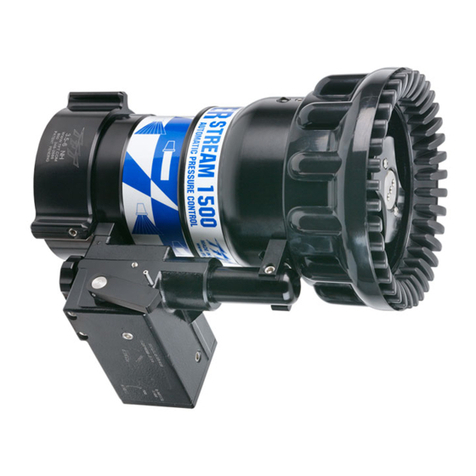
Task Force Tips
Task Force Tips Masterstream Series Quick guide
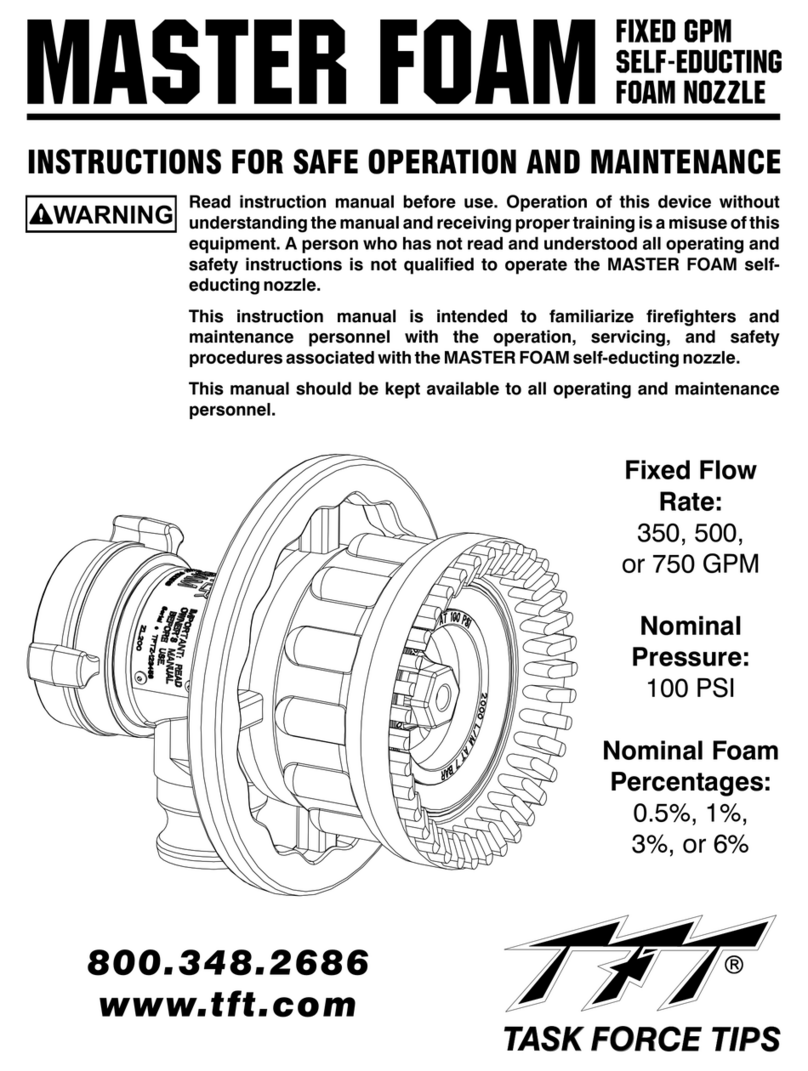
Task Force Tips
Task Force Tips MASTER FOAM Quick guide
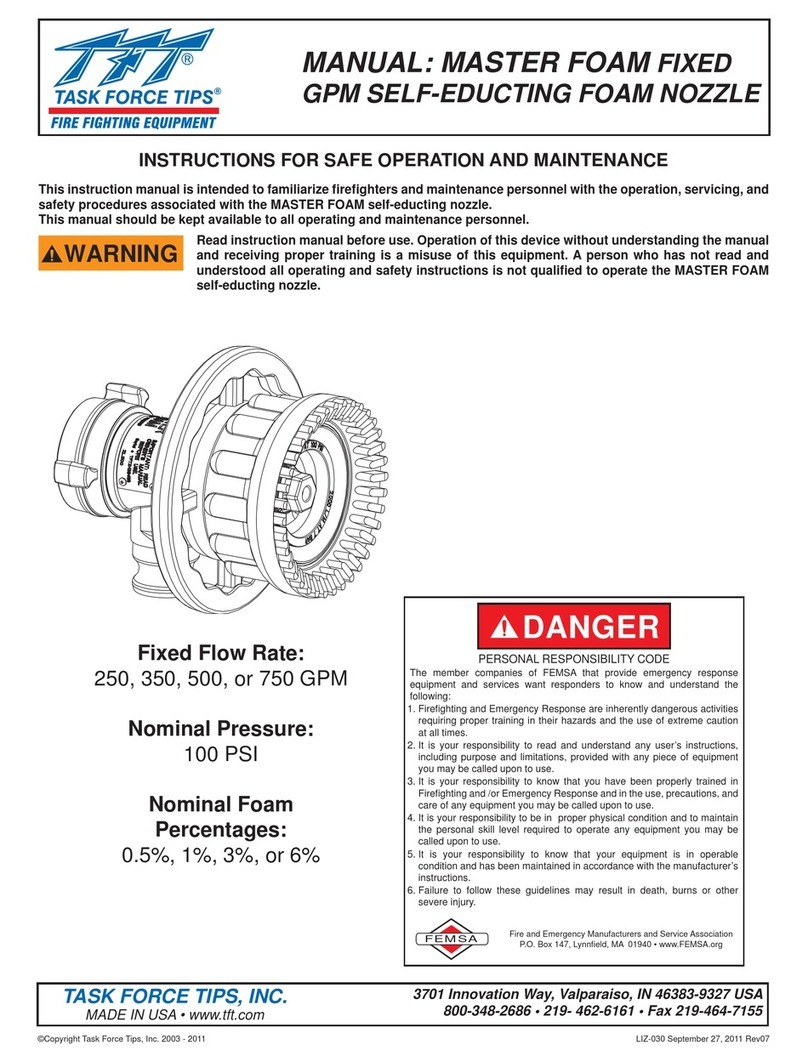
Task Force Tips
Task Force Tips MASTER FOAM Quick guide
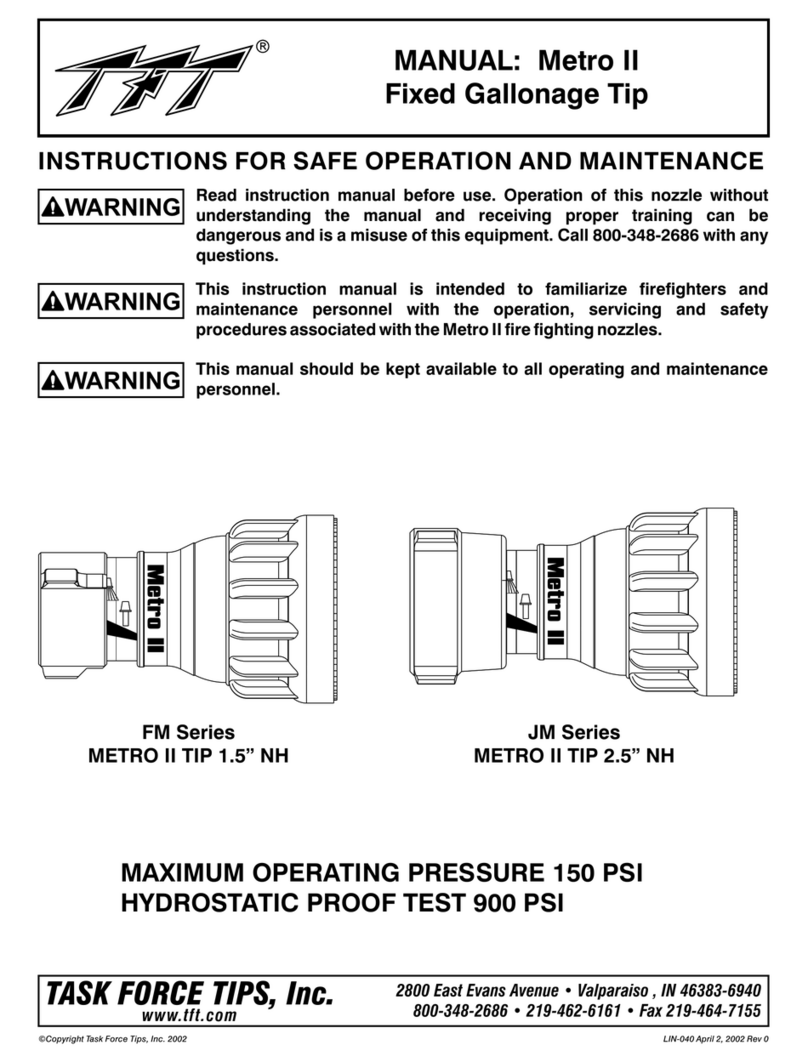
Task Force Tips
Task Force Tips FM Series Quick guide
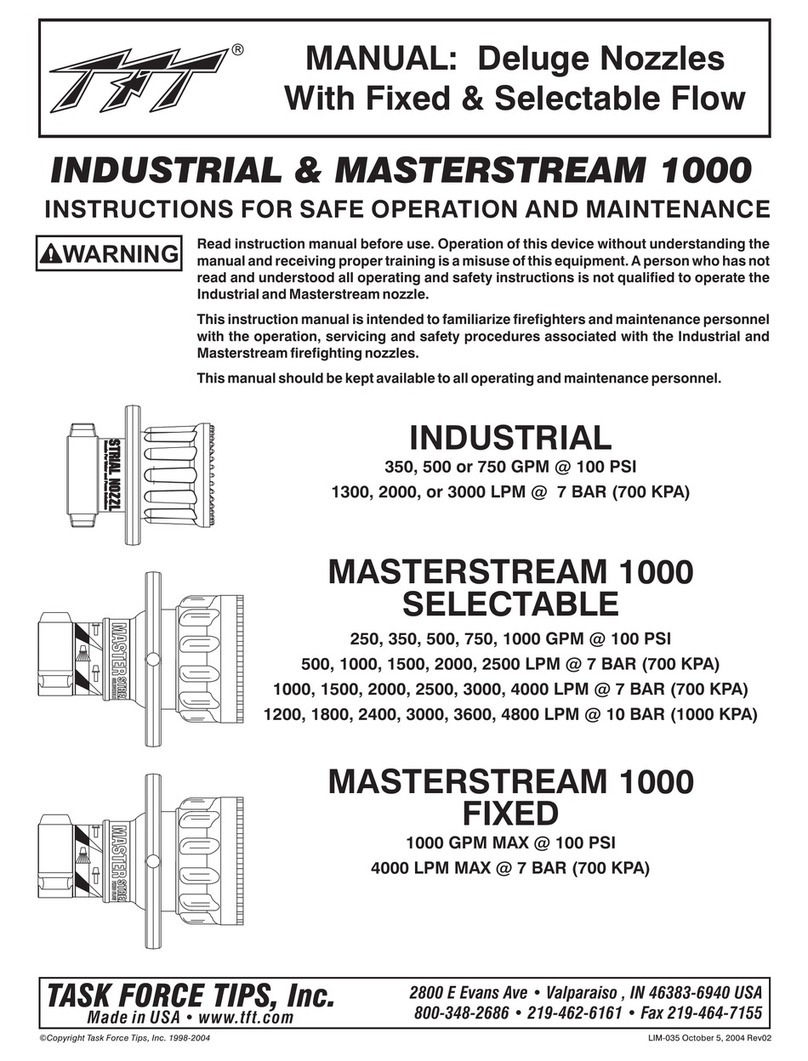
Task Force Tips
Task Force Tips MASTERSTREAM 1000 Series Quick guide

Task Force Tips
Task Force Tips G-Force Quick guide
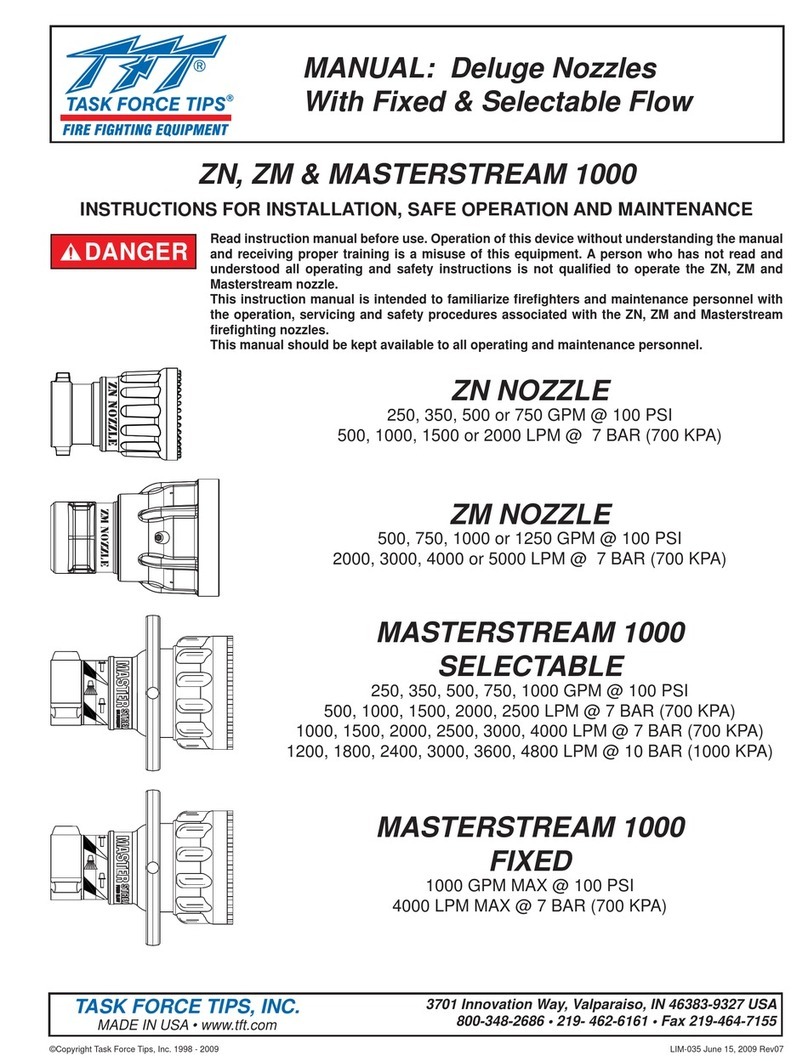
Task Force Tips
Task Force Tips ZN Series Programming manual

